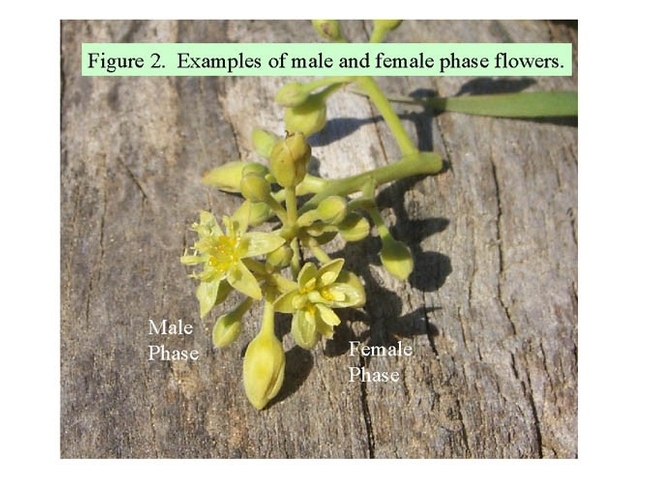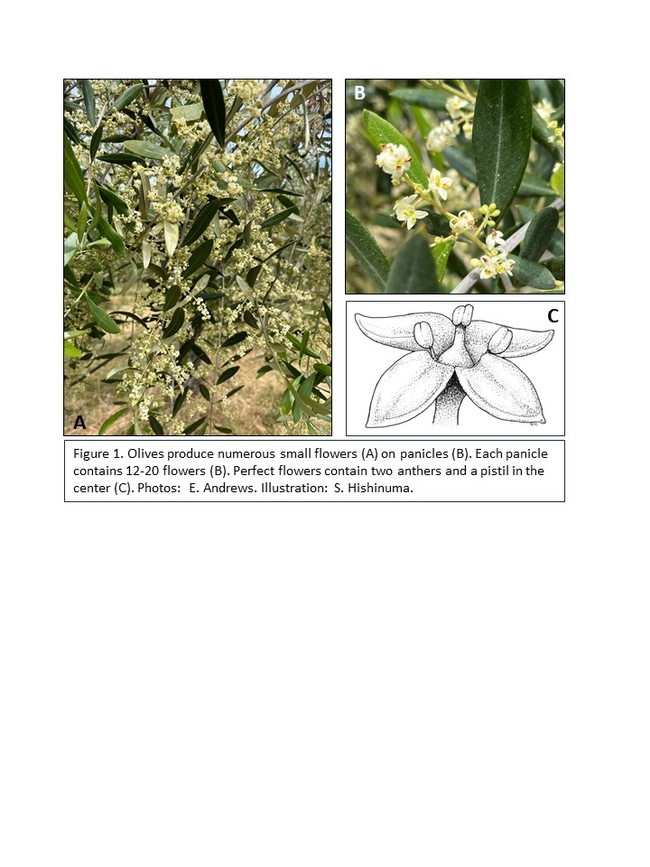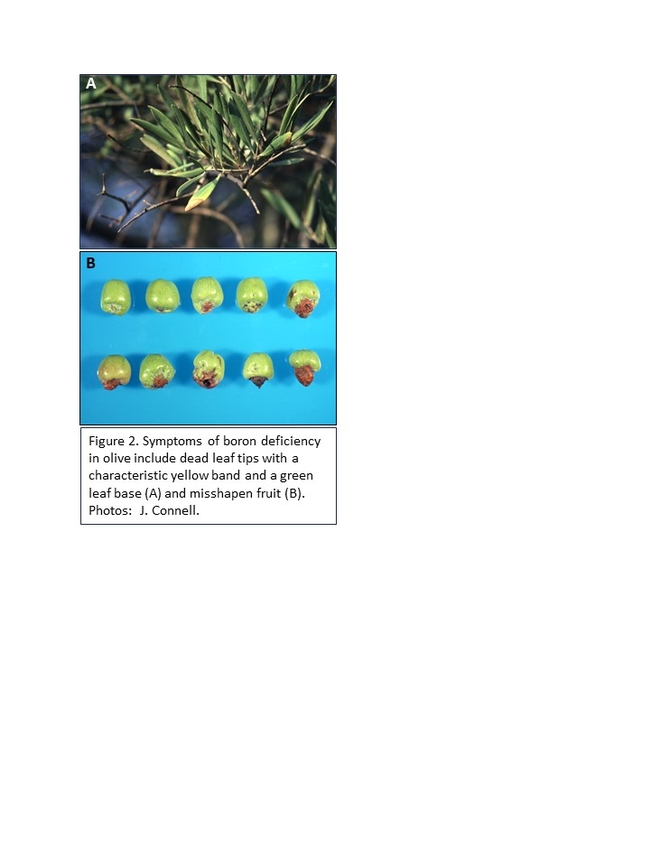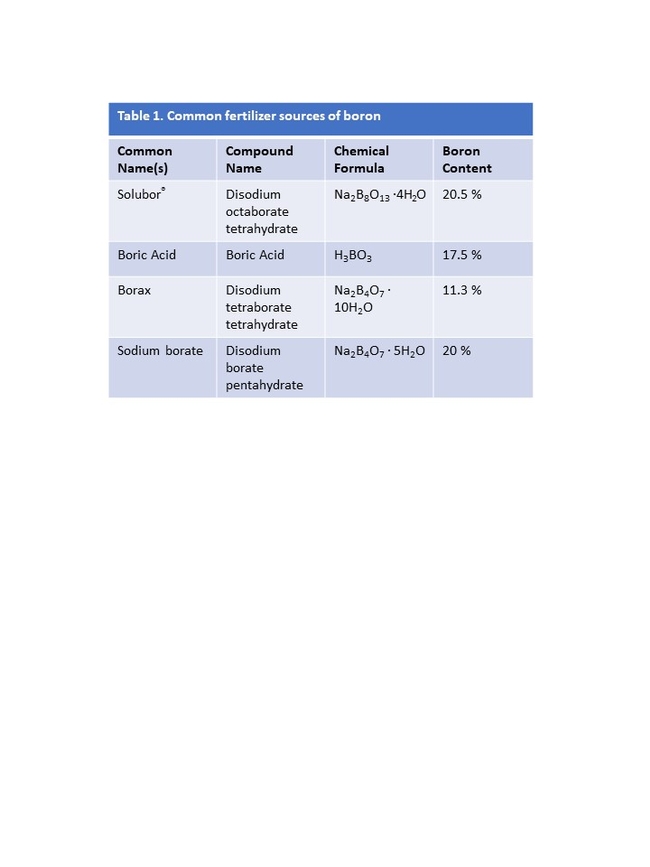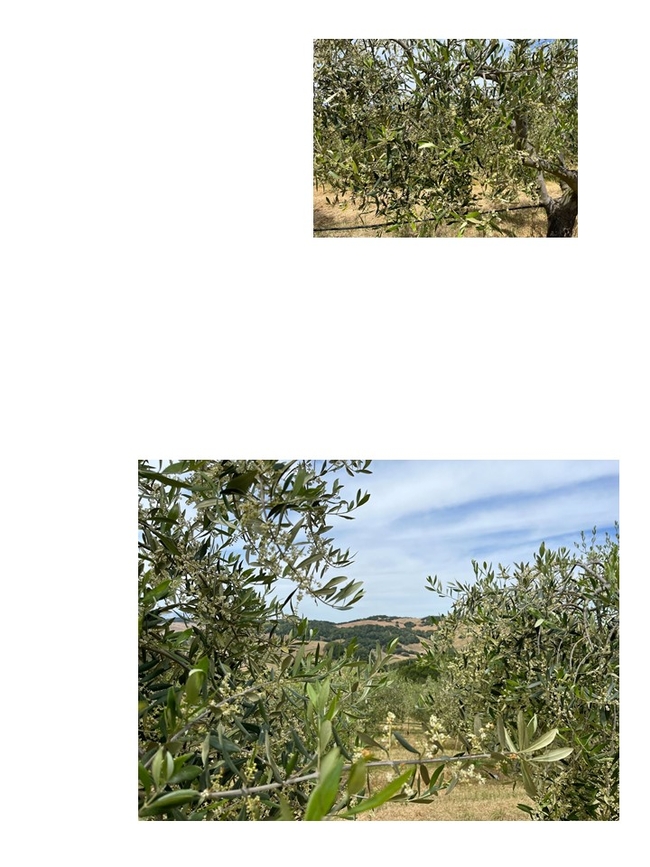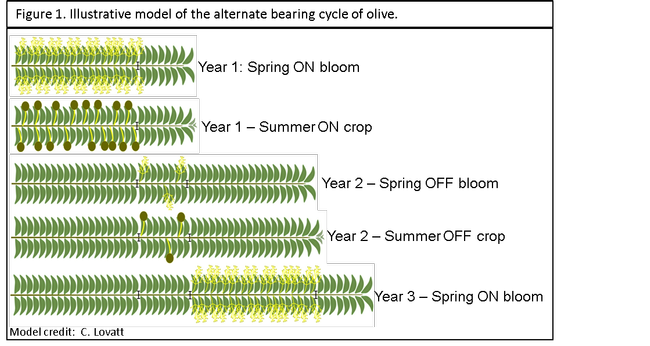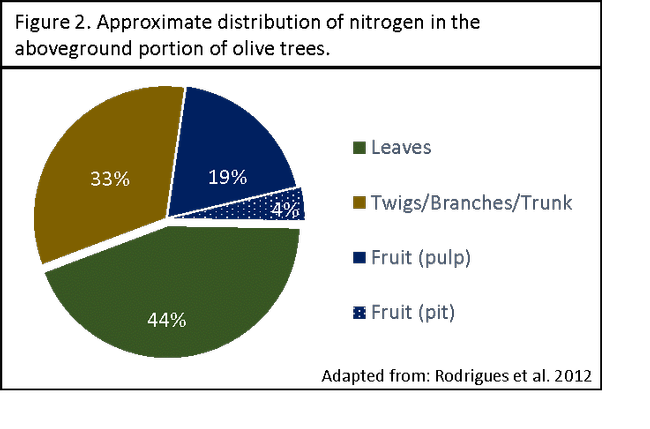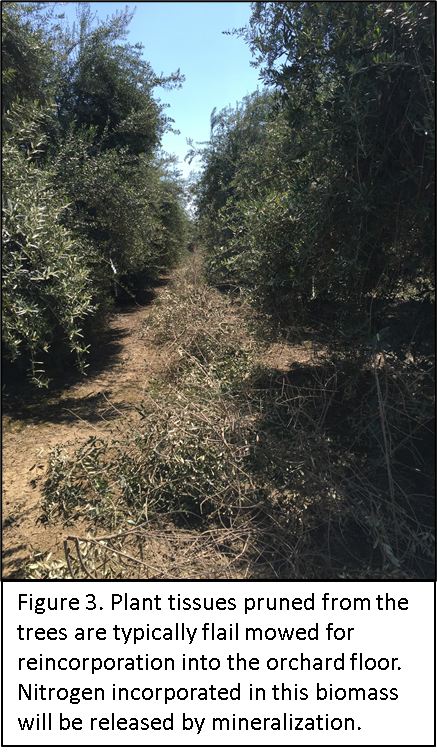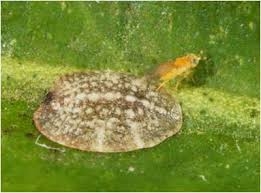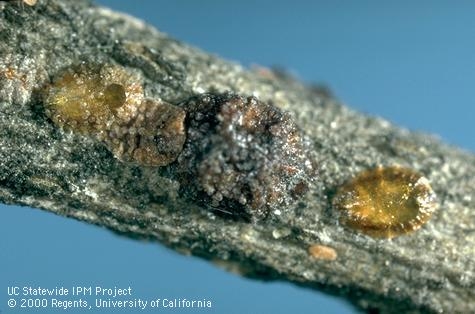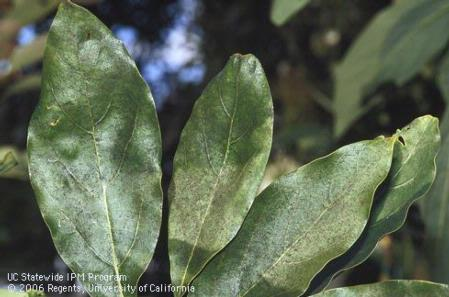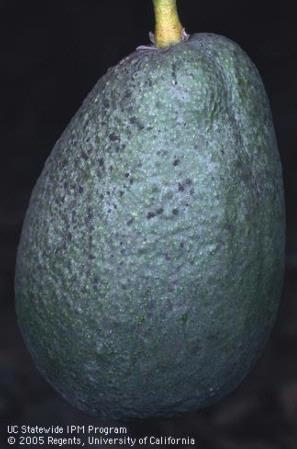Pre-bloom foliar boron application on olive
may improve yield
Ellie Andrews, PhD, UCCE Farm Advisor, Sonoma County, and Elizabeth Fichtner, PhD, UCCE Farm Advisor, Tulare County
Olive orchards entering an OFF year in 2024 may benefit from pre-bloom foliar boron (B) applications to support reproduction and yield. Because the 2023 California olive crop varied widely both within and between olive-growing regions, the value of boron applications should be considered at the individual orchard level. For example, in the southern San Joaquin Valley, the 2023 ‘Manzanillo' table olive crop was OFF due to the high temperatures at bloom whereas many oil cultivars in the region were unaffected by the heat and had heavy production. Those orchards that had a heavy ON crop in 2023 may benefit from pre-bloom boron application in the 2024 season.
Boron is an essential micronutrient for plant growth and reproduction. Boron deficiency affects plant reproduction by reducing pollen viability and germination and limiting pollen tube growth. Deficiency also limits the proportion of flowers that set fruit and reduces the retention of developing fruit. The influence of boron deficiency on multiple stages of reproduction may negatively impact yield. Boron also plays a role in vegetative growth and metabolism, ensuring cell wall and membrane integrity and facilitating sugar transport and cell division. Because boron plays a crucial role in reproduction, boron is translocated from vegetative tissues to reproductive tissues resulting in higher concentrations of the nutrient in reproductive organs than leaves. Due to this high demand, reproductive boron deficiency can occur even when vegetative boron and available soil boron are sufficient.
Studies conducted across numerous global olive-growing regions demonstrate the beneficial effects of foliar boron application on yield, particularly in advance of an OFF crop. The influence of boron application on productivity in olive orchards may relate to increases in photosynthesis, an increase in the number of perfect flowers (those with both male and female reproductive parts) (Figure 1), and an increase in pollen viability, or pollen tube growth. Olives are considered andromonoecious, a reproductive strategy in which plants bear both hermaphroditic (perfect) flowers and male flowers. Stress prior to bloom may cause pistil abscission in a fraction of buds resulting in a higher percentage of male flowers. Several research studies have demonstrated that pre-bloom foliar boron application can increase the percent of perfect flowers on trees, thus increasing the number of flowers capable of producing fruit. In olive, boron is readily mobilized from both young and old vegetative growth to support flower and fruit production; therefore, a portion of boron applied throughout the year may be utilized to support reproductive processes. During the pre-bloom season, however, cool temperatures and the corresponding reduced physiological activity may limit the uptake and translocation of boron in olive. Additionally, flowers are not as strong a boron sink as fruit; therefore, the pre-bloom foliar application may render the micronutrient available at a short-lived, yet critical, time in crop development.
Both oil olives and ‘Manzanillo' table olives have been shown to benefit from foliar boron applications. For example, ‘Arbequina' receiving pre-bloom foliar application of boron exhibited increased bloom and a 27% increase in yield in an OFF year. In the ‘Arbequina' study, no value of boron was observed in an ON year, and boron was found to have no effect on vegetative growth. In another study, boron applications to ‘Frantoio' resulted in increased concentration of chlorophyll and soluble sugars, as well as changes in the profile of endogenous plant growth regulators within the leaves. In California, pre-bloom boron applications on ‘Manzanillo' resulted in increased percentage of perfect flowers and improved fruit set and yield, particularly during an OFF year.
The recommended foliar boron concentration for olives ranges from 19-150 ppm. Values below 14 ppm boron may result in boron deficiency, whereas values above 185 ppm may result in boron toxicity. A foliar nutrient analysis only provides a snapshot of the status of the plant at the time of leaf collection; however, low boron status of leaves has been found to correlate well with symptoms of deficiency. Symptoms of boron deficiency in olive include dead leaf tips with a characteristic yellow band and green leaf base, as well as twig and limb dieback (Figure 1). Boron deficiency may first become apparent in the meristems, the growing tips of shoots. Boron deficiency may also result in misshapen and defective fruit (Figure 1), low fruit set, and premature fruit drop. The value of boron application for improved fruit set is not limited to orchards with visual symptoms of boron deficiency or foliar boron levels below the recommended range. In fact, the numerous research studies that demonstrate the value of pre-bloom foliar boron applications for enhanced fruit set and yield were conducted in orchards with no boron deficiency. Based on these findings, foliar analysis alone may not be a useful predictor of benefits from pre-bloom foliar boron application.
Boron is typically introduced to orchards either as a solid mineral broadcast on the soil surface, or in solution as a foliar spray. The pre-bloom foliar application is designed to specifically enhance fruit set and yield and should be applied three weeks prior to bloom. Boron is generally sold as borax, sodium borate, sodium tetraborate, boric acid, or Solubor® (Table 1). The boron content varies between formulations; therefore, all calculations should be based on the equivalents of active ingredient (ie. pounds of boron). For example, for soil-applied boron in olive, 5-10 lbs/acre of boron is broadcast, which equates to approximately 45-49 lbs/acre of borax (11% boron) or 24-48 lbs/acre Solubor® (20.5% boron). In California, foliar application of boron three weeks prior to ‘Manzanillo' bloom, particularly in OFF years, at rates of 1 or 2 lb./acre Solubor® in a 100 gallon/acre (246 or 491 mg/L boron at 935 L/hectare) was demonstrated to improve yield by approximately 30%. The baseline boron level in this California study site was 16 ppm boron, a level just below the established critical level, but high enough to avoid deficiency symptoms.
The value of boron applications on orchard health and economic return varies based on the status of the alternate bearing cycle in the year of application, the baseline boron status of the tree and soil, and other climate factors that may influence yield. Plants have a narrow range between boron deficiency and toxicity. Be sure to read the product label carefully to avoid over-application and conduct annual leaf tissue analyses to gather baseline information on the boron status of orchards. More information on fertilizer rates for olives and other California crops may be found on the CDFA FREP California Crop Fertilization Guidelines website (https://www.cdfa.ca.gov/is/ffldrs/frep/FertilizationGuidelines/).
Developing a nitrogen fertilizer plan for olive orchards
Elizabeth J. Fichtner, Farm Advisor, UCCE Kings and Tulare Counties
Nitrogen management plans (NMP) for California olive orchards are essential for the Irrigated Lands Regulatory Program and can increase net return. A good NMP has the potential to increase yield, improve oil quality and mitigate biotic and abiotic stresses while reducing nitrogen losses from the orchard.
Olives differ from other orchard crops in California in that they are both evergreen and alternate bearing. Individual leaves may persist on the tree for two to three years. Leaf abscission is somewhat seasonal, with most leaf drop occurring in late Spring. Rapid shoot expansion occurs on non-bearing branches during the hottest part of the summer (July-August) on ‘Manzanillo' olives in California. The fruit on bearing branches limits current season vegetative growth. Olives bear fruit on the prior year's growth, and the alternate bearing cycle is characterized by extensive vegetative growth in one year followed by reproductive growth the following year (Figure 1). With bloom occurring in late April to mid-May, fruit set can be estimated in early July, allowing for consideration of crop load while interpreting foliar nutritional analysis in late July-early August.
Critical Nitrogen Values. Foliar nitrogen content in July/August should range from approximately 1.3-1.7% to maintain adequate plant health. The symptoms of nitrogen deficiency manifest when foliar nitrogen content drops to 1.1% nitrogen. As leaves become increasingly nitrogen deficient, foliar chlorosis progresses from yellow/green to yellow. Leaf abscission is common at nitrogen levels below 0.9%. Nitrogen deficiency in olive is associated with a reduced number of flowers per inflorescence, low fruit set, and reduced yield.
Excess nitrogen (>1.7%) adversely affects oil quality. Oil with low polyphenol concentration is associated with orchards exhibiting excess nitrogen fertility. Since polyphenols are the main antioxidant in olive oil, reduced polyphenol levels are associated with reduced oxidative stability.
Nitrogen content may impact orchard susceptibility to biotic and abiotic stresses. For example, while excess nitrogen content has been associated with increased tolerance to frost prior to dormancy, in spring (post-dormancy) it is associated with sensitivity to low temperatures. High nitrogen content has also been associated with increased susceptibility to peacock spot, a foliar fungal disease on olive.
Foliar Sampling for Nitrogen Analysis. By convention, foliar nutrient analysis is conducted in late July-early August in California. Fully-expanded leaves are collected from the middle to basal region of the current year's growth at a height of about 5-8 feet from the ground. To capture a general estimate of the nitrogen status of the orchard, samples should be taken from 15-30 trees, with approximately 5-8 leaf samples collected per tree. Leaves for analysis should only be collected from non-bearing branches. Growers may find it beneficial to make note of the ON and OFF status in the historical records of each block. The orchard bearing status, combined with anticipated yield and foliar analysis will guide decisions for nitrogen applications the following year.
Distribution of nitrogen in the olive tree. Over 75% of the aboveground nitrogen in the olive tree is incorporated in the vegetative biomass (Figure 2). The twigs, secondary branches, main branches, and trunk account for approximately 33% of aboveground nitrogen (Figure 2). Twenty-three percent of the aboveground nitrogen is harbored in the fruit, with the majority in the pulp (19%) (Figure 2). Fruit is only an important nitrogen sink during the initial phase of growth. As fruit size increases, the N concentration decreases due to dilution.
Estimation of nitrogen removed from the orchard. The easiest component of orchard nitrogen loss to estimate is the nitrogen in the harvested fruit. A ton of harvested olives removes approximately 6-8 lbs of nitrogen from the orchard. The quantity of nitrogen in the fruit varies slightly between olive varieties (Table 1). Growers can use the Fruit Removal Nutrient Calculator for Olive on the California State University, Chico (CSU Chico) website to gain estimates of N removal by the three oil varieties (Arbequina, Arbosana, and Koroneiki), and the Manzanillo table olive. This tool was developed by Dr. Richard Rosecrance (Professor, CSU Chico) and Bill Krueger (Farm Advisor, UCCE). To access the Fruit Removal Nutrient Calculator for Olive, visit the following URL:
http://rrosecrance.yourweb.csuchico.edu/Model/OliveCalculator/OliveCalculator.html
Pruning may generate a second component of nitrogen loss from orchards. The best practice to mitigate nitrogen loss from pruning is to reincorporate the pruned material into the orchard floor by flail mowing. The nitrogen in this organic material will gradually become available to the trees through mineralization.
In mature orchards, the wood removed by annually pruning is approximately equal to the annual vegetative growth. Consequently, the input and removal of nitrogen in vegetative growth is cyclic and almost equal in mature orchards. In young orchards, nitrogen inputs are utilized to support vegetative growth and little nitrogen is removed from the orchard in prunings or crop. During this time nitrogen must be supplied to meet the demand to support vegetative growth. It is estimated that approximately 2.5 lbs nitrogen is required to produce 1,000 lbs. fresh weight of tree growth.
Nitrogen Use Efficiency. Not all the nitrogen supplied to the orchard from fertilizer and other inputs (ie. organic matter, irrigation water) is utilized for tree growth and crop production. A fraction of nitrogen is lost from the orchard ecosystem through processes such as runoff, leaching, and denitrification. Efficiency varies among orchards, with some orchard systems exhibiting higher nitrogen utilization rates than others. The efficiency generally varies from 60% - 90%. Higher values denote more efficient use of nitrogen inputs. To estimate the amount of nitrogen to supply an orchard, the demand is divided by the estimated efficiency. For example, if nitrogen demand is 50 lbs. per acre and efficiency is estimated at 0.8, then 62.5 lbs. of nitrogen per acre should be applied.
Summary. Nitrogen management plans are site-specific and designed to meet orchard and crop demand while reducing environmental losses. Nitrogen utilization is never 100% efficient. Nitrogen use efficiency can be maximized by minimizing losses from irrigation and fertilization practices while utilizing foliar analysis and knowledge of alternate bearing status to fine-tune applications.
Select References:
Fernández-Escobar, et al. 2011. Scientia Horticulturae 127:452–454.
Hartman, H.T. 1958. Cal Ag. Pgs 6-10.
Rodrigues, M.A. et al. 2012. Scientia Horticulturae 142:205-211.
- Author: Ben Faber
We live in unusual times and every year is different, so we are bound to see things that are different, or see things differently. Recently a pest control advisor brought in a sample of what looked like black scale (Saissetia oleae) on the stems of avocado fruit. Along with the scale came a mess of Argentine ant and sooty mold. The PCA had not seen this scale on avocado before. It is common on citrus and, from the name, it is also found on olives and over 100 other host-plants. I hadn't seen it on avocado before, and became somewhat alarmed and sent samples off to UC Riverside for identification. I thought maybe there might have been an introduction of a new scale, riding on imported fruit. Joe Morse and crew from UCR had done a study monitoring fruit coming across the border and found several scales on fruit that were not currently in California:
http://entnemdept.ufl.edu/Hodges/als4161/Secure/PDF%20Files/Articles/AvocadoPhytosanitaryRisks.pdf
Back with the first infestations of Avocado thrips in 1996, PCA Charlie Gribble kept saying that he was finding citrus thrips in avocado. The avocado orchards where he found the thrips were next to a lemon orchard and we kept saying that the insect was probably just getting lost between the two orchards. Well it turned out, it wasn't citrus thrips, but an all new thrips previously undescribed that has gone on to cause a lot of disruption to the California avocado industry. And from here, avocado thrips has gone on to Israel and Spain to cause similar problems. It was better to find out sooner than later it this scale was something new.
I also put the word out to local PCAs and growers asking if they had seen “black scale” this year. The responses were interesting. One grower said that he had seen it occasionally on avocado trees for the last 30 years. They were on older trees and wood. They would be in small numbers in orchards some years and not others. Two PCAs said that they saw it occasionally on young trees, but they were usually parasitized, with wasp exit holes. One PCA said that the scale was only there when there were lots of ants present to fend off parasitic wasps.
Photos: parasitic wasp laying eggs and exit hole of young wasp from adult scale
And bingo, that was the case in this organic orchard with smaller trees. The Argentine ants were protecting the scale and the scale was thriving as evidenced by the sooty mold.
The black scale samples sent into Paul Rugman-Jones at UCR Entomology were identified as the scale Saissetia olea and that virtually all of them were parasitized by the Coccophagus rusti wasp. So it's not a new scale and it's under biological control.
Photos: Sooty mold on avocado leaves and fruit
Nice coverage of scales:
https://www.dialenvironmental.com/images/scales.pdf
http://ipm.ucanr.edu/PMG/r107301411.html
For a guide to the scales of California, big files and illustrations:
https://www.cdfa.ca.gov/plant/PPD/publications/tech_series.html
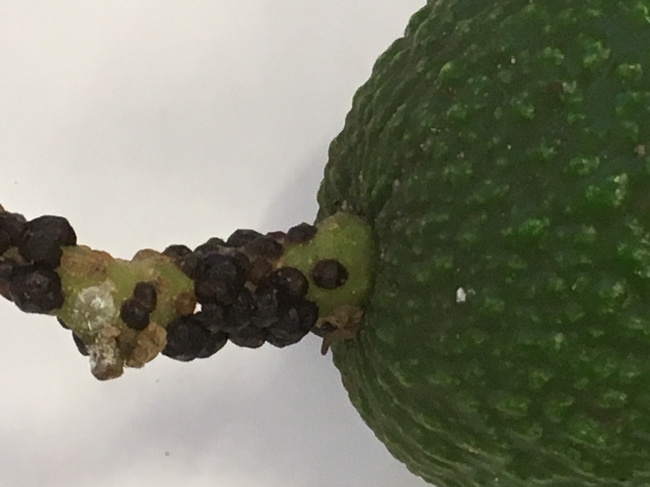
- Author: Elizabeth Fichtner
Recent advances in understanding the history of olive domestication
Elizabeth Fichtner, Farm Advisor, UCCE Tulare and Kings Counties
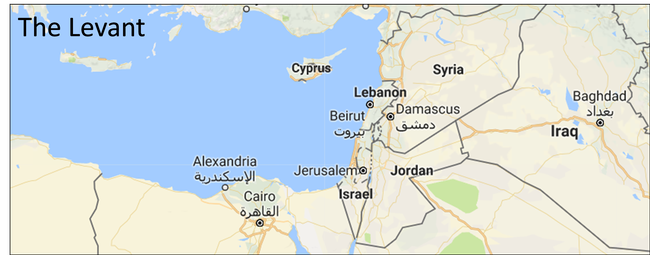 Olives are thought to have first been domesticated in the northeastern Levant, an area near the border of present-day Turkey and Syria. Map captured from Google Maps. |
With the emergence of the California olive oil industry, the state has witnessed a dramatic diversification in the olive cultivars grown commercially. Our mainstay black ripe olive industry, dominated by the ‘Manzanillo' olive, is now combined with increasing acreage of Spanish, Greek, and Italian cultivars used to create high quality, extra virgin oil. The historic table olive industry of California still represents around 18,000 acres of olives in the state, while approximately 40,000 acres are currently devoted to oil production.
Although olive cultivation in California is relatively new (dating back to the historic Spanish Missions established by Franciscan priests), olives are of key importance in the history and culture of the Mediterranean basin. A recent publication by a group of European, American, and North African scientists has re-evaluated the location of the domestication of the olive, providing genetic evidence that domestication occurred in the northeastern Levant, close to the present-day border of Syria and Turkey.
To complete the study, researchers collected plant material from nearly 2000 trees, sampling both wild oleaster populations and domesticated cultivars of olive. World Olive Germplasm Banks in Córdoba (Spain) and Marrakech (Morocco) served as sources of the majority of cultivars included in the study. Researchers utilized the genetic sequences of plastids (ie. chloroplasts) to discern differences between cultivars and wild oleaster populations. Plastids are organelles (structures inside cells) that contain their own DNA. Since plastids are generally inherited from one parent (similar to mitochondria), their genetic sequences are more conserved then that of nuclear DNA, which is contributed by both parents. Since olive is a wind-pollinated crop, nuclear DNA may be disseminated over large distances.
The genetic analysis of wild populations indicates three distinct lineages of olive: the Near East (including Cyprus), the Agean area, and the Straight of Gibralter. These three wild populations are likely linked to refuge areas where populations persisted through historic glaciation events. Interestingly, the geographic distribution of these three populations also corresponds to the subdivisions of the olive fruit fly, suggesting that these regions offered shared refuge habitat for both the host and the pest. The wild oleaster population in the eastern Mediterranean was found to be more diverse than previously thought and ninety percent of the present-day cultivars analyzed in the study matched this group. Common olive cultivars grown in California, including, Sevillano, Arbosana, Arbequina, and Koroneiki, all belong to this group originating in the eastern Mediterranean.
As a result of this study, it is proposed that the initial domestication of olive took place in the northeastern Levant; subsequently, plant material was disseminated to the whole Levant and Cyprus before being spread to the western Mediterranean. After these initial domesticated trees spread throughout the Mediterranean basin, they likely underwent subsequent domestication events by crossing with wild oleasters, thus introducing genetic material from the other two ancient western Mediterranean lineages.
Such studies may appear purely academic; however, they can also address more timely questions and assist in characterizing cultivars. For example, a 2010 study in California made genotypic comparisons between historic olive plantings in Santa Barbara, CA and at Santa Cruz Island, CA. The study elucidated that the olives on Santa Cruz Island, planted in the late 19th century are different than other historic olive plantings in Santa Barbara, CA. Olives planted at the Santa Barbara Mission in the late 18th century are the ‘Mission' cultivar, whereas those on Santa Cruz Island (Figure 3) are generally ‘Redding Picholine.' Interestingly, the olives on Santa Cruz Island are thought to have been planted for oil production, but there are no historic reports of harvest or sale of a crop. Additionally, the Santa Cruz Island olives have become somewhat invasive on the island due to their propensity to establish from seed. As a result of genotypic analysis of these populations and the fact that ‘Picholine' makes an excellent rootstock due to its ease of propagation from seed, it is hypothesized that the ‘Picholine' variety was intended as a rootstock, but the grafts never took. Consequently, maturation of a ‘Picholine' orchard may have just been an accident, a mistake, or simply bad luck. The completion of this local population genetics study may have helped explain the unsolved mystery of the historically unharvested trees on Santa Cruz Island.
Find Santa Cruz Island.
Besnard, G., Khadari, B., Navascués, M., Fernández-Mazuecos, El Bakkali, A., Arrigo, N., Baali-Cherif, D., Brunini-Bronzini de Caraffa, V., Santoni, S., Vargas, P., Savolainen, V. 2013. The complex history of the olive tree: from Late Quaternary diversification of Mediterranean lineages to primary domestication in the northern Levant. Proc R Soc B. 280: 20122833.
Soleri, D., Koehmstedt, A., Aradhya, M.K., Polito, V., Pinney, K. 2010. Comparing the historic olive trees (Olea europaea L.) of Santa Cruz Island with contemporaneous trees in the Santa Barbara, CA area: a case study of diversity and structure in an introduced agricultural species conserved in situ. Genet Resour Crop Evol 57:973-984.
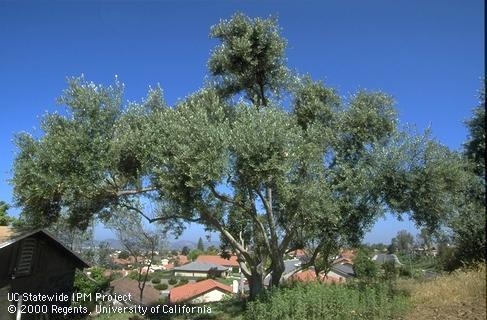
- Author: Ben Faber
The latest edition of Topics in Subtropics newsletter is out, Elizabeth Fichtner as editor. Read on.
TOPICS IN THIS ISSUE:
-
Why has California red scale been so difficult to control?
-
Navel Orange Nitrogen Fertilization
-
Recent Advances in Understanding the History of Olive Domestication
- Upcoming UC Olive Center Events

